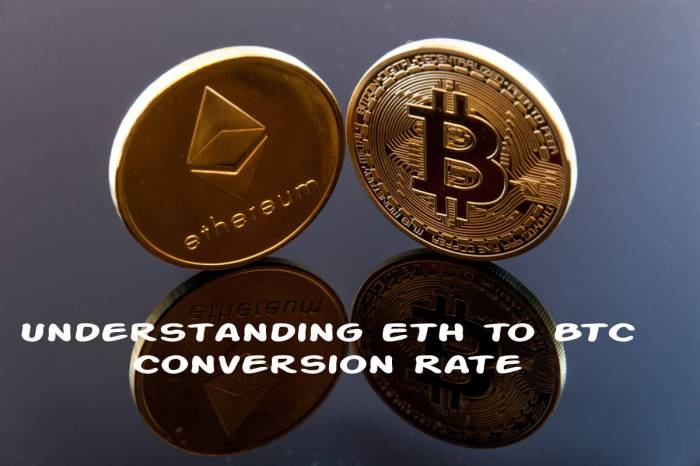Which is worth it, Btc or Eth – In the ever-evolving realm of cryptocurrency, a captivating narrative unfolds, pitting two titans against each other: Bitcoin (BTC) and Ethereum (ETH). As the crypto landscape continues to reshape, the question that lingers on every investor’s mind is: which digital asset holds the key to unlocking unparalleled value?
Delve into this enthralling tale as we embark on a comprehensive analysis of BTC and ETH, unraveling their technological prowess, market dynamics, and investment potential. Prepare to witness a clash of the crypto titans, where only one can emerge as the ultimate victor.
Market Trends

Bitcoin (BTC) and Ethereum (ETH) have dominated the cryptocurrency market for years, each boasting unique characteristics and value propositions. Historically, BTC has maintained its position as the market leader, while ETH has gained significant traction as a platform for decentralized applications (dApps) and smart contracts.
Current market conditions reflect the evolving dynamics between these two giants. BTC has recently experienced a surge in value, driven by factors such as increasing institutional adoption and geopolitical uncertainties. ETH, on the other hand, has shown resilience amidst market volatility, supported by its strong ecosystem and growing developer community.
Market Projections
Market projections for BTC and ETH vary widely, but many analysts anticipate continued growth for both assets in the long term. Factors such as increasing global crypto adoption, technological advancements, and regulatory clarity are expected to drive the value of these cryptocurrencies higher.
However, it’s important to note that the cryptocurrency market remains highly volatile, and short-term fluctuations are common. Investors should exercise caution and conduct thorough research before making any investment decisions.
Technological Advancements
Beneath the surface of Bitcoin (BTC) and Ethereum (ETH) lies a world of technological innovation that has shaped their evolution and continues to drive their future. Let’s dive into the underlying technologies, exploring their scalability, security, and efficiency, to understand how these advancements are shaping the landscape of digital assets.
Scalability
Scalability refers to a platform’s ability to handle an increasing number of transactions without compromising performance. BTC’s blockchain, with its limited block size, faces scalability challenges, leading to slower transaction times and higher fees during periods of high network usage.
In contrast, ETH’s transition to a proof-of-stake consensus mechanism and its implementation of sharding, a technique that distributes transaction processing across multiple nodes, aims to enhance its scalability.
Security
Security is paramount in the world of cryptocurrencies. BTC’s blockchain is known for its robust security, relying on the proof-of-work consensus mechanism, which requires miners to solve complex mathematical problems to validate transactions. This process ensures the immutability and integrity of the network.
Whether it’s Bitcoin’s dominance or Ethereum’s versatility, the crypto market offers a wealth of opportunities. For those seeking to maximize their potential, How to Day Trade Crypto: A Comprehensive Guide for Beginners provides invaluable insights into the art of day trading cryptocurrencies.
Understanding the intricacies of day trading can help you make informed decisions about which assets, like Bitcoin or Ethereum, align with your investment goals and risk tolerance.
ETH, on the other hand, while initially relying on proof-of-work, has transitioned to proof-of-stake, which reduces energy consumption but raises questions about its long-term security implications.
Efficiency
Efficiency encompasses the platform’s ability to process transactions quickly and cost-effectively. BTC’s blockchain, with its slower transaction times, can be less efficient for smaller transactions. ETH, with its faster block times and lower gas fees (transaction costs), offers improved efficiency for everyday use cases.
However, ETH’s efficiency can be impacted during periods of high network congestion.
Ecosystem Development: Which Is Worth It, Btc Or Eth
The growth and adoption of BTC and ETH ecosystems have been remarkable. Both platforms have attracted a vast number of developers, users, and applications, creating vibrant and thriving communities. This ecosystem development has significantly contributed to the value and utility of BTC and ETH.
Developer Activity
BTC and ETH have fostered large and active developer communities. Developers are drawn to these platforms due to their open-source nature, strong security, and vast resources available. The number of developers working on BTC and ETH projects has been steadily increasing, indicating the continuous innovation and growth within their ecosystems.
User Adoption
BTC and ETH have gained widespread user adoption, becoming the most popular cryptocurrencies globally. The number of users holding and transacting in BTC and ETH has grown exponentially, demonstrating the increasing acceptance and trust in these platforms. The adoption of BTC and ETH as payment methods by businesses and the development of decentralized applications (dApps) have further contributed to their user base.
Application Development
The BTC and ETH ecosystems have witnessed the development of a wide range of applications, including decentralized finance (DeFi), non-fungible tokens (NFTs), and decentralized autonomous organizations (DAOs). These applications have expanded the use cases of BTC and ETH, enabling users to access financial services, create and trade digital assets, and participate in governance.
The growth of the application ecosystem has attracted more users and developers, creating a virtuous cycle that further strengthens the BTC and ETH ecosystems.
Use Cases and Applications

The primary use cases for BTC and ETH stem from their unique properties and technological capabilities. BTC, with its scarcity and immutable nature, has gained prominence as a store of value and digital gold. ETH, on the other hand, is a programmable blockchain platform that enables the creation and execution of decentralized applications (dApps), smart contracts, and non-fungible tokens (NFTs).
BTC as a Store of Value
- BTC’s limited supply of 21 million coins and its decentralized, trustless nature make it an attractive asset for investors seeking a hedge against inflation and geopolitical risks.
- Its high liquidity and global acceptance facilitate seamless transactions and value transfer across borders.
ETH for Decentralized Applications
- ETH’s smart contract functionality allows for the creation of tamper-proof, automated agreements that execute predefined conditions without the need for intermediaries.
- DApps built on ETH can offer a wide range of applications, including decentralized finance (DeFi), supply chain management, gaming, and social media.
- NFTs, which are unique digital assets stored on the ETH blockchain, have gained popularity in the art and collectibles market.
Advantages and Limitations
While BTC and ETH share some similarities, their use cases and applications result in distinct advantages and limitations:
- BTC:High security, limited supply, store of value, low transaction fees.
- ETH:Smart contract functionality, programmability, dApp development, higher transaction fees.
Impact on Demand and Value
The diverse use cases and applications of BTC and ETH drive demand and value for these cryptocurrencies. BTC’s scarcity and role as a store of value attract investors seeking a safe haven asset, while ETH’s versatility in dApp development and NFT creation fosters innovation and adoption.
Regulatory Landscape
The regulatory landscape surrounding Bitcoin (BTC) and Ethereum (ETH) is constantly evolving, with governments and regulatory bodies around the world grappling with the challenges of regulating these decentralized technologies. The impact of regulations on the value and adoption of BTC and ETH is complex and multifaceted, and it is still too early to say definitively how regulatory developments will shape the future of these platforms.
Amidst the cryptosphere’s ever-evolving landscape, the debate between Bitcoin (BTC) and Ethereum (ETH) rages on. Both giants offer distinct value propositions, leaving investors pondering which path to tread. If you’re a crypto novice seeking guidance, consider exploring How Trading Crypto Works: A Beginner’ . This comprehensive guide unravels the complexities of crypto trading, empowering you to navigate the digital asset realm with confidence.
Once equipped with the knowledge, you can return to the BTC vs. ETH conundrum and make an informed decision, charting your path towards crypto success.
One of the key challenges for regulators is to find a way to balance the need to protect consumers and investors with the need to foster innovation and economic growth. Regulations that are too strict could stifle innovation and prevent the development of new technologies, while regulations that are too lax could put consumers at risk.
Regulators must also consider the global nature of cryptocurrency markets, and the need to coordinate with other countries to develop a consistent regulatory framework.
Impact of Regulations, Which is worth it, Btc or Eth
- Regulations can impact the value of BTC and ETH by increasing or decreasing demand for these assets. For example, if a government announces plans to crack down on cryptocurrency trading, the price of BTC and ETH could fall as investors become more risk-averse.
- Regulations can also impact the adoption of BTC and ETH by making it more difficult for businesses to accept these assets as payment. For example, if a government requires businesses to obtain a license to accept cryptocurrency payments, some businesses may decide that it is not worth the hassle and expense to do so.
Regulatory Developments
Regulatory developments are likely to continue to have a significant impact on the future of BTC and ETH. As governments and regulatory bodies around the world continue to grapple with the challenges of regulating these decentralized technologies, it is important for investors to stay up-to-date on the latest regulatory developments.
Some of the key regulatory developments that could impact the future of BTC and ETH include:
- The development of a global regulatory framework for cryptocurrency markets.
- The classification of BTC and ETH as securities by regulatory bodies.
- The implementation of anti-money laundering and know-your-customer (KYC) regulations for cryptocurrency exchanges.
Institutional Adoption

Institutional adoption plays a pivotal role in shaping the legitimacy and stability of cryptocurrencies. Both BTC and ETH have witnessed a surge in institutional interest, driven by factors such as:
- Diversification of portfolios
- Potential for high returns
- Hedging against inflation
As institutions allocate funds to these assets, they provide a strong foundation for long-term growth and stability. The presence of reputable institutional investors instills confidence in the market, attracting more participants and boosting liquidity.
Impact on Value and Stability
Institutional adoption has a direct impact on the value and stability of BTC and ETH. Large inflows of capital from institutional investors can drive up prices, while their presence as long-term holders provides stability during market fluctuations.
Moreover, institutional adoption enhances the credibility of these assets, making them more attractive to retail investors and further bolstering their value. The involvement of reputable institutions also reduces volatility, as they tend to trade in larger blocks and take a more strategic approach to investing.
Supply and Demand Dynamics

The supply and demand dynamics of Bitcoin (BTC) and Ethereum (ETH) play a crucial role in determining their value and price fluctuations. Understanding these dynamics is essential for investors and traders seeking to navigate the cryptocurrency market.
The supply of BTC and ETH is limited by their respective issuance mechanisms. BTC has a finite supply of 21 million coins, while ETH has a more flexible supply with no predetermined limit. However, ETH’s issuance rate is subject to periodic adjustments through its monetary policy.
Whether it’s Bitcoin (BTC) or Ethereum (ETH), the crypto market offers a wealth of opportunities. To navigate its complexities, How to Profit Trading Crypto: A Comprehensive Guide provides invaluable insights and strategies. This guide empowers you to make informed decisions, whether you’re a seasoned trader or a curious beginner.
By understanding the nuances of each coin, you can maximize your returns and ultimately determine which asset is worth your investment.
Issuance and Distribution
- BTC:BTC’s issuance is controlled by its mining algorithm, which creates new blocks and releases a predetermined number of coins as a reward to miners. The block reward is halved every four years, gradually reducing the rate of new BTC entering the market.
- ETH:ETH’s issuance is managed by its proof-of-stake consensus mechanism. Validators who stake their ETH to secure the network receive rewards in the form of newly issued ETH. The issuance rate is adjusted based on factors such as network activity and gas fees.
Before embarking on your crypto trading journey, a crucial question arises: which cryptocurrency reigns supreme, Bitcoin (BTC) or Ethereum (ETH)? While both giants hold their own merits, the decision ultimately depends on your investment goals. For a comprehensive guide to navigating the crypto market as a beginner, explore How to Start Trading Crypto for Beginners: A Comprehensive Guide . This invaluable resource empowers you with the knowledge to make informed decisions and potentially reap the rewards of the crypto realm.
With a solid understanding of the basics, you can confidently determine whether BTC or ETH aligns better with your investment strategy.
The distribution of BTC and ETH is influenced by various factors, including mining pools, exchanges, and individual investors. A concentrated distribution, where a small number of entities hold a large proportion of the supply, can affect the market’s liquidity and price volatility.
Price and Value
Supply and demand dynamics directly impact the price and value of BTC and ETH. When demand for these assets exceeds supply, their prices tend to rise. Conversely, when supply exceeds demand, prices may fall.
Factors such as investor sentiment, market news, and technological developments can influence supply and demand, leading to price fluctuations. The finite supply of BTC has historically contributed to its scarcity premium, while ETH’s more flexible supply allows for greater price elasticity.
Risk and Return Analysis

Investing in cryptocurrencies like Bitcoin (BTC) and Ethereum (ETH) carries both potential rewards and risks. Understanding the risk-return profile of these assets is crucial for informed investment decisions.
Historical Volatility
BTC and ETH have historically exhibited high volatility, with significant price fluctuations over short periods. This volatility stems from factors such as market sentiment, regulatory changes, and technological advancements. The annualized volatility of BTC and ETH has been around 60% and 50%, respectively, over the past few years.
Risk-Adjusted Returns
Despite the volatility, BTC and ETH have also generated substantial returns for investors over the long term. However, the risk-adjusted returns, which consider both potential returns and volatility, provide a more comprehensive view of investment performance. The Sharpe ratio, a common measure of risk-adjusted return, has been positive for both BTC and ETH, indicating that they have outperformed the risk-free rate after adjusting for risk.
Investment Implications
The risk and return profiles of BTC and ETH influence investment decisions in several ways:
-
-*Risk Tolerance
Investors with a high risk tolerance may be more inclined to invest in BTC and ETH, given their potential for higher returns.
-*Investment Horizon
These assets are typically considered suitable for long-term investments due to their high volatility and the potential for significant price swings in the short term.
-*Diversification
BTC and ETH can be used as part of a diversified portfolio to reduce overall risk. Their low correlation with traditional assets, such as stocks and bonds, can enhance portfolio returns and reduce volatility.
Investment Strategies

Deciding on an investment strategy is crucial for maximizing returns and managing risks. Both BTC and ETH offer distinct opportunities, requiring tailored strategies to optimize outcomes. Let’s explore various investment approaches for each cryptocurrency and guide you in selecting the one that aligns with your risk appetite and financial objectives.
Whether it’s Bitcoin or Ethereum, the allure of cryptocurrencies lies in their potential profitability. To navigate the volatile waters of crypto trading, understanding how to calculate your profit is crucial. Refer to the comprehensive guide How to Calculate Profit in Crypto Trading to unravel the intricacies of profit calculation.
Armed with this knowledge, you can discern the true worthiness of Bitcoin and Ethereum, unlocking the potential for lucrative crypto investments.
To begin, let’s compare the different investment strategies for BTC and ETH in a comprehensive table:
| Strategy | BTC | ETH |
|---|---|---|
| Buy-and-Hold | Long-term investment, HODLing coins over extended periods | Similar to BTC, HODLing ETH for potential long-term appreciation |
| Trading | Short-term profit-taking by buying and selling within shorter time frames | Active trading to capitalize on ETH’s price fluctuations |
| Staking | Earning rewards by holding and validating transactions on the blockchain | Staking ETH to participate in the network’s consensus mechanism |
| Mining | Verifying transactions and creating new coins, requiring specialized hardware | Mining ETH using GPUs or ASICs |
Each strategy has its advantages and drawbacks:
- Buy-and-Hold:Pros – Simple and accessible, suitable for long-term investors seeking steady growth. Cons – Requires patience and tolerance for market volatility.
- Trading:Pros – Potential for higher returns in shorter time frames. Cons – Requires skill, market knowledge, and risk tolerance.
- Staking:Pros – Passive income stream, supporting network security. Cons – Rewards can fluctuate based on network activity.
- Mining:Pros – Direct involvement in the blockchain, potential for high returns. Cons – High upfront investment, energy-intensive, and competitive.
Choosing an appropriate investment strategy depends on your individual risk tolerance and financial goals. If you seek long-term appreciation with lower risk, buy-and-hold or staking might be suitable. For those comfortable with higher risk and active trading, trading or mining could offer opportunities for greater returns.
Last Point

As the curtains fall on this captivating crypto saga, we are left with a profound understanding of the intricate forces that shape the value of BTC and ETH. The choice between these digital giants ultimately rests upon the individual investor’s risk tolerance, financial goals, and belief in the transformative power of blockchain technology.
May this journey have illuminated your path, empowering you to make informed decisions in the ever-shifting crypto landscape. Remember, the true worth of any investment lies not solely in its monetary value but in its ability to align with your aspirations and drive innovation in the digital realm.
FAQ Insights
What factors should I consider when choosing between BTC and ETH?
Your investment goals, risk tolerance, and belief in the long-term potential of each asset should guide your decision.
Which asset is more volatile, BTC or ETH?
BTC has historically exhibited higher volatility compared to ETH, but both assets are subject to market fluctuations.
Is it possible to invest in both BTC and ETH?
Yes, many investors diversify their crypto portfolios by allocating funds to both BTC and ETH.





